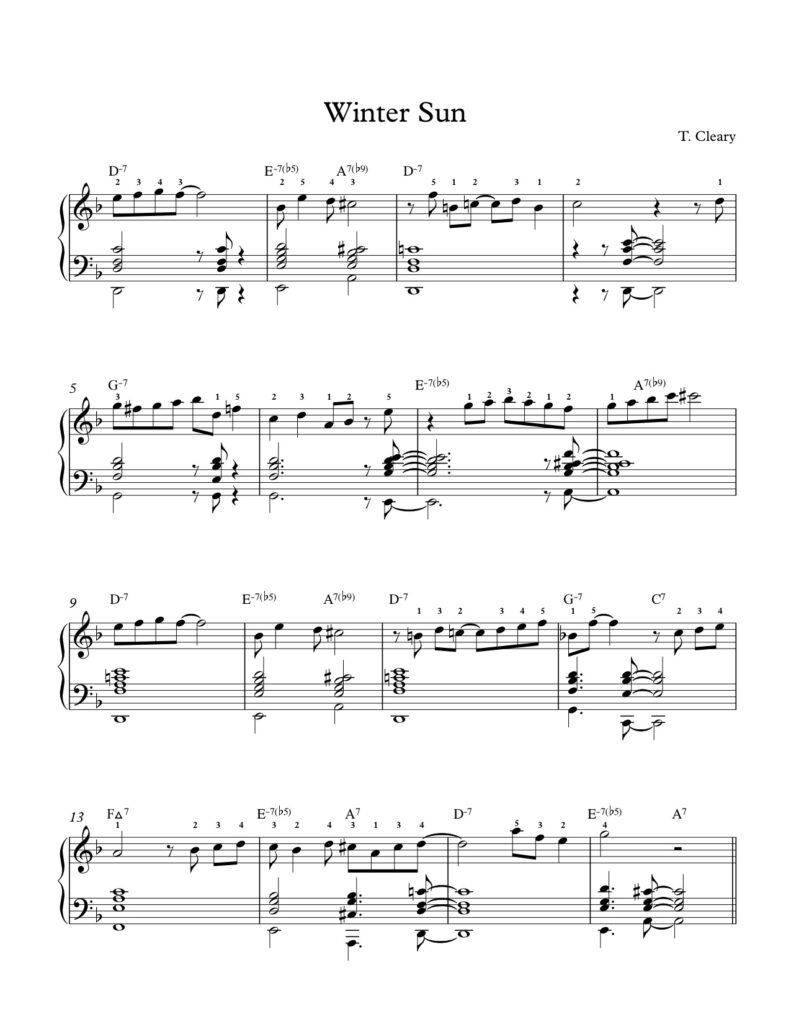Like George and Ira Gershwin’s ‘I Got Rhythm’ and W.C. Handy’s ‘Saint Louis Blues’, the song ‘Summertime’, composed in 1934 by Gershwin with lyrics by DuBose Heyward (originally for the opera Porgy and Bess), has been a standard throughout nearly all eras of jazz. Listening to versions of this tune by great jazz players in chronological order from earliest to latest can provide a mini-history of jazz, from Sidney Bechet’s version recorded in 1939 not long after the tune’s publication, to Louis Armstrong and Ella Fitzgerald’s version from 1958 with an arrangement using some of Gershwin’s original orchestration, to Miles Davis’ version from the same year with an arrangement by Gil Evans that epitomizes the modal jazz style (which would gain wider exposure the following year on ‘Kind of Blue’). Herbie Hancock’s version featuring Joni Mitchell’s vocals and Stevie Wonder’s harmonica playing, from his album ‘Gershwin’s World’, demonstrates a late-twentieth-century modern jazz approach to the tune, rife with altered dominant chords. ‘Summertime’ has also been interpreted by many artists in the wider popular music world, notably Janis Joplin whose version with Big Brother and The Holding Company casts the tune in 6/8 swing feel with baroque-style counterpoint between two guitars. A version by Prince from a soundcheck shows his lesser-known skills with jazz piano comping and soloing. (Prince’s posthumous autobiography, ‘The Beautiful Ones’, devotes a considerable amount of space to describing his father as a working jazz pianist.) In Shulie-A-Bop, Sarah Vaughan uses the ‘Summertime’ chord progression as the basis for her original wordless scat vocal line which avoids referencing Gershwin’s melody. A further development of the ‘Summertime’ chord progression can be heard in Wes Montgomery’s Four on Six, which retrofits Gershwin’s basic harmonic structure with a number of additional ii-V progressions and adds a new melody .
The chart below for my tune ‘Winter Sun’, which is also based on the chord progression of ‘Summertime’, may be played two ways. While it can be played as a ‘two-hand comp’ (with the single note roots shown in the bass clef with ‘down stems’ played in the left hand, and the three- and four-note voicings shown higher in the bass clef in the right hand), I recommend first learning the treble-clef melody in the right hand and the three- to four-note voicings on the upper part of the bass clef in the left hand. (In this melody and chords version, the left hand would obviously not play the roots shown lower in the bass clef along with the chords.) I would recommend starting by learning the left hand voicings at a very slow tempo and then practicing them along with Chet Baker’s quartet version of Summertime at .75 or .5 speed on YouTube. Baker’s version, more than most of the versions mentioned above, shows the common practice of how the tune is played in most jazz situations. To help you learn the melody, here’s a link to an informal solo piano recording of the tune from a very fun gig I played recently for the opening of The Piano Gallery, a new retail piano outlet run by piano tuners and dealers Justin and Emily Rose. As I was playing the tune from memory on this recording, some of the voicings are different than those shown on the score; I also made a slower recording of just the melody which demonstrates the written voicings. Like a number of my contrafact tunes, ‘Winter Sun’ also works as a countermelody to ‘Summertime’. It also includes a reference to the melody of ‘Autumn Leaves’ (with one inverted interval) and a reference to Ella Fitzgerald’s iconic ‘Blue Skies’ solo – see if you can find them!

Thanks for the comment, Alden, these links are a great addition to the music mentioned in the post.
Summertime gained an additional identity when it was loosely covered (or served as an inspiration, some would say) by Sublime in 1997, replacing the opening lyric “summertime” with “doin’ time”. Their single heavily utilizes samples of Herbie Mann’s live 1961 rendition of Summertime, most importantly a vamplike vibraphone loop. The release included remixes by rap group The Pharcyde, as well as by Wyclef Jean. It has since been sampled / remixed by many rappers, most notably Snoop Dogg. Just last year, genre-bending pop star Lana Del Rey released an immensely successful cover of Sublime’s “Doin’ Time”.
On a related note — in 1964, The Zombies released a minimalist rendition of “Summertime” in the same 6/8 feel that Joplin would use a few years later.
Sublime:https://www.youtube.com/watch?v=H3ypeugNzYA
Herbie Mann: https://www.youtube.com/watch?v=JbWg_xKyi-M
The Pharcyde: https://www.youtube.com/watch?v=84fhnHhmHTc
Wyclef Jean: https://www.youtube.com/watch?v=NOLaQMuRHPI
Snoop Dogg: https://www.youtube.com/watch?v=V2Q6Xe57z3Q
Lana Del Rey: https://www.youtube.com/watch?v=qolmz4FlnZ0
The Zombies: https://www.youtube.com/watch?v=RKu2P8zT_F4